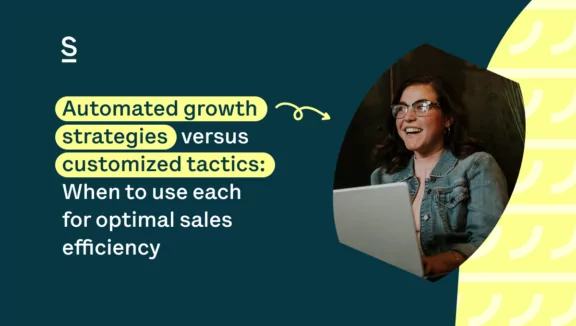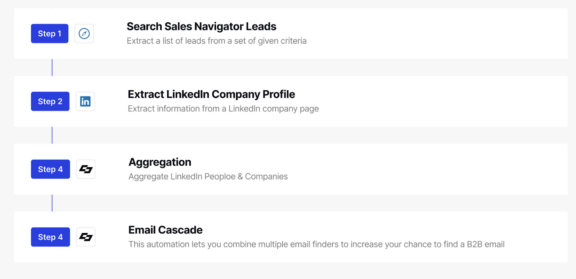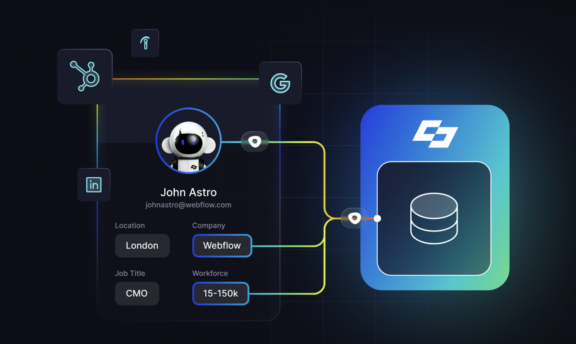Automated growth strategies versus customized tactics: When to use each for optimal sales efficiency

A guest blog contributed by Captain Data, a no-code data automation platform for sales & ops teams.
“Sales efficiency.” It’s the little-known metric packing a huge wallop when it comes to measuring sales performance —and success.
As a metric, sales efficiency shows you how every dollar spent on expenditures and investments into sales and marketing activities directly affects revenue.
What you really want is a sales efficiency ratio that indicates that every dollar spent on sales and marketing activities is generating 2, even 3 times more in revenue than what you spent.
So if you’re trying to understand whether your sales results actually contribute to revenue, sales efficiency is your man on the ground.
Now, here’s the thing: “efficiency” also tells you that the metric is a good measure and test of whether your sales enablement strategy is actually efficient enough.
Wasting time, money, and resources on manual tasks often leaves sales personnel unable to drive conversations or connections that create sales. Instead of interacting with prospects, they’re struggling simply to find them and incorporate them into your CRM.
In this article, we’re going to compare two tactics for optimizing your sales efficiency —automated growth strategies versus customized processes. There’s a justification and power in using each —as long as you use them right.
Let’s dive right in.
Using Automation to Improve Efficiency in High-Volume Campaigns
Do you have a sales process in place? Of course, you do. Do you spend time generating leads and adding them to your database? Without a doubt.
But are you doing so in a way that makes the best use of your salespeople’s time and attention? That is what sales efficiency can help you identify. And with a sales efficiency ratio lower than 0.5 —or at break-even, which is between 0.5 and 1 —you have a clear case for some deeper investigation.
It’s estimated that inefficiencies eat into as much as 20-30% of an organization’s revenue. Ask yourself: what could you do with 20 to 30% more?
The key to eliminating the kind of waste —or, conversely, the kind of bloat —that comes from inefficiencies is automation. What automation means in the context of sales activities is creating a repeatable workflow or process that does the heavy lifting for you. Each step of the sales process still requires completion, but harnessing automation means software features do it for you instead.
All the way back in 1989, Harvard Business Review found that automation (which hadn’t reached the level of sophistication it has now) would be a game changer for marketing sales.
Why?
Because, even in the early days, automation “drives the collection of more complete customer and marketplace information, and more informed decision making targets marketing and sales activities where they are most effective.”
So how do you cut lead generation time while boosting response rates to 20% or ensure that your data enrichment takes less time while producing high-quality, accurate, and fresh data?
Automation can deliver those kinds of results.
Automating the Sales Process
You want less process and more actual work — but that doesn’t mean the sales process isn’t important. It simply means that it needs to be outsourced.
And instead of outsourcing it to another company, which still presents a dollar value cost for your balance sheet, you’ll want to consider outsourcing the process to automation: it asks for no extra human capital. Still, it delivers repeatable, consistent results at scale.
When it comes to scaling sales ops and processes using automation, Basile Greiveldinger, Global Sales & Operations Manager at Agicap, puts it like this: “Once you’ve got more than 5 salespeople, doing things manually just doesn’t cut it anymore.”
More sales personnel should mean revenue growth —but if you’ve got five individuals wasting time on the same set of tasks to run the sales process, it’s five times the inefficiency.
Let’s say you’re turning to the web to hunt for leads —an integral part of your outbound efforts.
Before you can ever present the right offer to the right individual at the right time, or send out a cold email, you need to identify your prospects. You also need to tap into more detailed insights that will help initiate meaningful, even personalized, conversations and interactions.
In short, you need to build an enriched lead list that includes accurate data for decision-makers, including company information and verified emails. If you’re after the high-volume way, use data automation to , capture more than a thousand leads in about 10 minutes.
Arnaud Renoux, Growth Manager at Scalelab used automation to retrieve data about individuals on LinkedIn as well as company profiles, aggregate this enriched data, and combine multiple email finders, increasing the chances of retrieving B2B emails.
Not only does an automated data enrichment workflow cut down on the number of steps, thus pruning the process, but none of your sales personnel also need to be directly involved. Take a look at how this looks in action here.
If you’re big on using LinkedIn Sales Navigator, tools like Surfe can also help you export contacts or full lead lists created on the platform to your CRM.

Suddenly, a sales efficiency ratio of 1 and above seems right within reach.
Renoux reports: “[Automation] gives you lots of headspace for creativity, because all the manual work is completely taken care of.”
That’s 1,000 fresh, high-quality leads in 10 minutes — and you can consistently run this process repeatedly. Even if 10% of these convert into your sales funnel, that’s 100 prospects ready to hit for your sales team and your outbound marketing campaign — multiplied by as many times as you run this automated process.
Using Automation for A/B Testing and Optimization
Lead generation is one aspect of the sales funnel process. But equally important is A/B testing and the resulting optimization. A/B testing is an essential part of your deep dive into improving sales efficiency.
Once data automation has helped you with lead generation and database creation, it’s time to harness its power for A/B testing. In the context of sales and marketing, here’s how it works:
- Based on your ICP framework, create initial messages for a cold email. You can create more than two, but two messages are best to keep your results specific and clear.
- Separate your recipients into Control A and Group B. Most of the message should remain the same except for one variable — this can be a CTA, a button color, the offer you make, etc.
- Track opens, click-throughs, or any other actions that your recipient might take.
- The message with a higher EPM or CTR is the clear winner. This is the one you’ll use to send to the rest of your customers that match that particular profile.
Running A/B tests is all about allowing data to lead the way. You’re looking for clear performance indicators that show you that one message is stronger than the other. And having a larger sampling size (i.e. a greater number of leads with which to run tests) can help you understand which messages were effective when it comes to conversion (taking an action).
However, the performance of your automation is not just about CTRs or conversion rates. It can be something as simple as unsubscribes —which automation message or sequence has a lower unsubscribe rate? Any data you compile about the performance of one automation versus another can help you optimize future campaigns.
Of course, at that point, you might want to test variations in other variables based on campaign goals —for example, customer winbacks. Think of these as controlled experiments run with the goal of making better decisions about sales activities.

Customization for Building Stronger Customer Relationships
So, automation helps sales professionals spend more time concentrating on selling instead of doing the corollary work, like data enrichment and lead compilation in a manual way.
But, at a certain point of the sales funnel, customization is the key to building strong customer relationships. And that’s what sales is all about, after all.
Now, here’s the thing: sales efficiency as a metric is not entirely foolproof. It tracks how well money was generated from new sources rather than also including revenue from previous ones. If you’ve properly incorporated cross-selling and upselling into your sales enablement program, your team may still be extremely effective without it necessarily reflecting in the efficiency ratio.
Cross-selling and upselling both come down to strong relationships. These usually occur later in the relationship —once a qualified lead has become a paying customer.
However, customization can also begin at an earlier, pre-sales stage, when a potential customer has taken an action but hasn’t converted into a user or customer. They may have responded to an automation email that included a particular kind of discount. Or they may have booked a demo or opted into a trial, which signals interest.
This information is usually captured as behavioral data in a CRM and sales personnel will use that information to tailor or “customize” future interactions — whether that’s through direct, person-to-person conversations or email follow-ups. Incorporating marketing automation solutions can greatly enhance this process, as these tools help track and analyze customer behavior, enabling sales teams to deliver highly personalized experiences even at early stages of the sales funnel.
A tool like Surfe can make it even easier to take notes on prospects, providing note-taking functionalities on LinkedIn, where most conversations happen if you’re in B2B. Surfe also syncs all that to the CRM, so no information gets left behind. And, the notes are at your fingertips should you need them -no need to dig the database for relevant prospect info. Even if you harness automation as part of your sales process, customization is the other half —the human half —of the picture.
Don Busick, executive vice president and head of enterprise products and platforms at Capital One says, “At its core, personalization is about knowing your customers and preferences so you can surface exactly what [they] need when it matters.”
Since deal cycles today consist of more touch points with a greater number of stakeholders —Forrester estimates that’s a total of 27 interactions with 11 business stakeholders for B2B purchase decisions — it’s more important than ever to customize each interaction based on a prospect’s past behavior or even their preferences. If you’re talking to someone on LinkedIn, Surfe can help you create and reuse customizable message templates. This additional context is what helps build a relationship over those series of interactions.
These details, captured in a CRM, become a sales professional’s go-to differentiator because it gives them context for conversations that engage buyers in a repeatable way. And since the modern buyer is active on a variety of channels, from email and websites to Zoom calls, social media, and text, customization can help sales teams trigger online discussions and build credibility. And in a way that references their buyer’s interactions on these mediums.
This potentially shortens the deal cycle. Overall, customizing your interactions with specific, tailored offers or messages that are based on historical data can create a situation where your prospect is compelled to say, “yes!”
You’ve made it easy for them to do so.
Using Customization to Stand Out in a Crowded Market
When buyers go everywhere, customization helps you stand out from the crowd.
Let’s say you’re focusing on leads generated from the social channel, LinkedIn. You use data automation to collect these enriched leads and add prospects to your CRM in one click. In this example, you could decide to tailor your approach based on their job role.
However, existence in an omnichannel landscape means that they’ve interacted with comparable brands and businesses on other platforms as well. So you’ll need to consider how their interactions or offers presented on these other platforms are being received.
Customization takes a multi-pronged approach —it’s not simply about past purchasing behavior. When you’re first understanding how to stand out and connect with your prospects, customizing your outreach means understanding that prospects are looking for personalization right from the start.
According to McKinsey:
- 67% of first-time prospects expect tailored messages from businesses they’re purchasing from.
- 65% believe that if they’re being offered targeted promotions, they should receive something “just for them.”
- 59% expect businesses to anticipate where they are and send “timely communications tied to key moments.”
And personalization affects buyers’ decisions across the lifecycle — they begin with a purchase, but are more likely to repurchase and recommend. What does this mean for revenue? Companies naturally capture more value from personalization, allowing them to grow revenue faster — 40% more.
Conclusion
When it comes to reaching that optimal sales efficiency ratio over 3, automation without the context of customization is a dead-end process. And customization without the power of automation is going to feel like a draining and inefficient task.
To truly optimize sales efficiency, you’ll need to aim to weave both together into a seamless strategy that keeps your customer’s needs right at the center.


